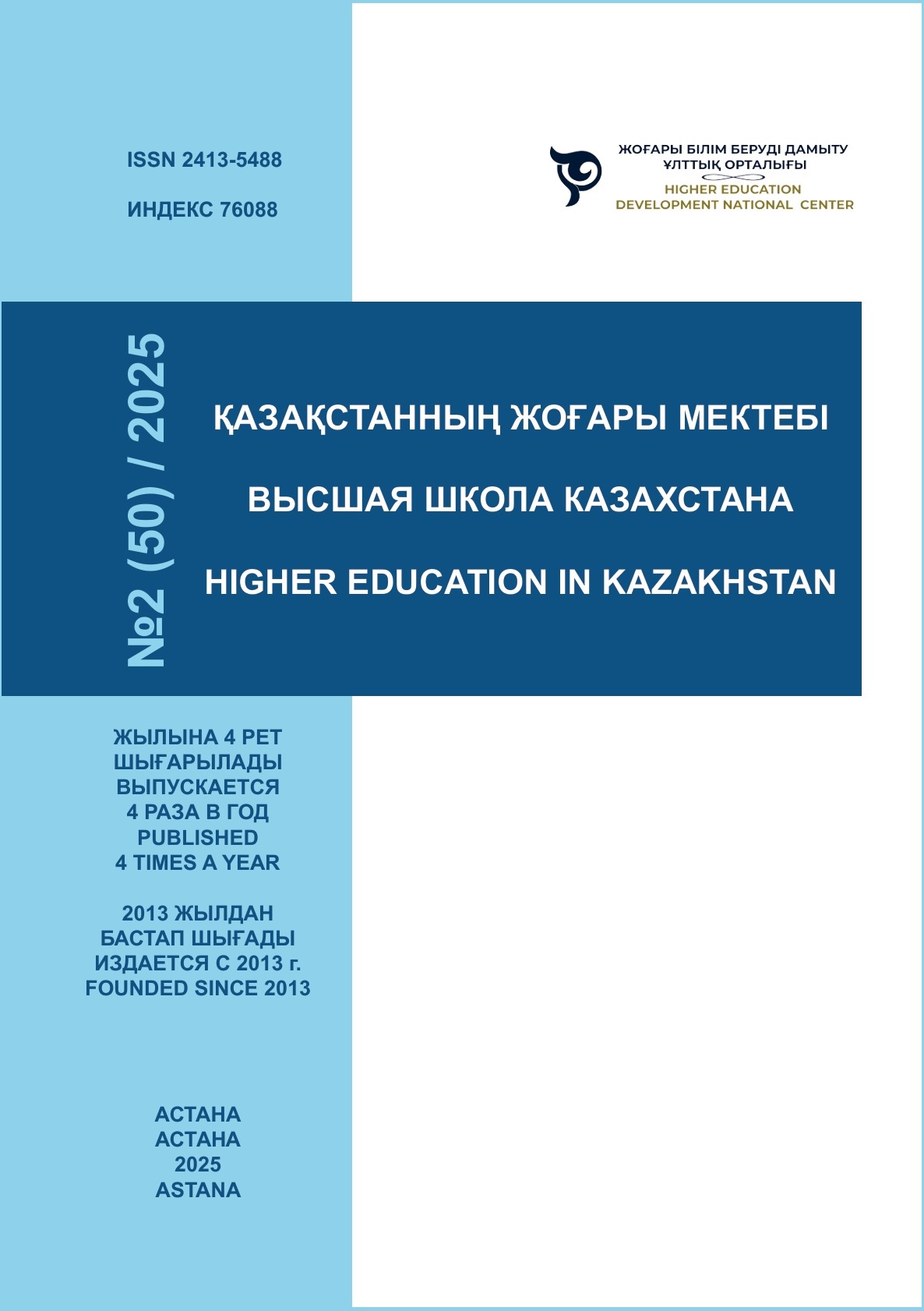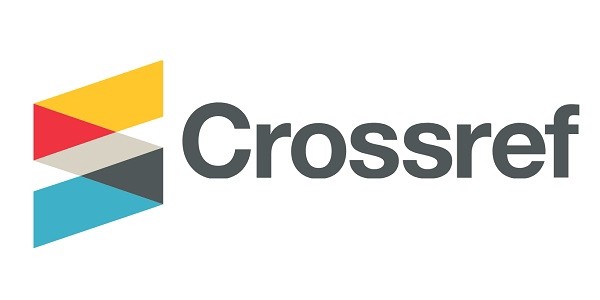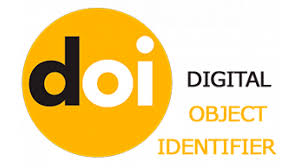BILINGUAL EDUCATION: ANALYSIS OF SCIENTIFIC PUBLICATIONS IN SCOPUS
DOI:
https://doi.org/10.59787/2413-5488-2025-50-2-32-50Аңдатпа
The article considers bilingualism as one of the main trends in the linguistic development of society. Bilingual education is an important component of the educational process. The purpose of the work is to analyze the dynamics and content of scientific publications in order to identify the main directions of development and trends in the field of bilingual education. The research methodology includes the collection of data on the keywords "bilingualism" and "education", processing and analysis of 7609 publications using the statistical package SPSS and qualitative analysis programs, which allows for a multi-level analysis of thematic, geographical, and temporal aspects. The theoretical significance of the research lies in the systematization of knowledge about bilingual education, deepening understanding of the multidisciplinary nature of this field of research. The practical significance is expressed in the possibilities of using the results to develop strategies for preserving linguistic diversity and promoting intercultural communication. The results of the study showed a significant increase in the number of studies on bilingual education. Geographical and industry analysis of publications show the global and interdisciplinary nature of the research area. The conclusions of the study are that, in the context of globalization and digitalization of public space, it is important to continue research related to bilingual education in order to better understand the relationship between language, society, and culture.
Әдебиеттер тізімі
Abdulina, A. (2022). Languages and cultures of representatives of the main ethnic groups of Kazakhstan through the prism of the Kazakh model of interethnic consent. Edu E-History Kz, 30(2), 4-17. https://doi.org/10.51943/2710-3994_2022_30_2_4-17
Adnyani, L., Laksono, K., Anam, S., & Suhartono, S. (2023). Equitable education for bilingual autism spectrum disorder children. Proceedings of the 4th International Conference on Educational Technology and Computer Science, 158-166. https://doi.org/10.2991/978-2-38476-010-7_19
Akkaya, G., & Ertekin, P. (2021). İki kere farklı bireylere yönelik literatürün görsel olarak incelenmesi: Bibliyometrik bir çalışma. Pamukkale University Journal of Education. https://doi.org/10.9779/pauefd.706012
AlShamsi, A., & Alsheikh, N. (2020). Sociocultural integration of bilingualism and biliteracy of Emiratis: Exploratory study in a group of fifth-grade students. The Southeast Asian Journal of English Language Studies, 26(3), 66-80. https://doi.org/10.17576/3l-2020-2603-06
Anderson, L. M., Scrimshaw, S. C., Fullilove, M. T., Fielding, J. E., & Normand, J. (2003). Culturally competent healthcare systems: A systematic review. American Journal of Preventive Medicine, 24(3 SUPPL.), 68-79. https://doi.org/10.1016/S0749-3797(02)00657-8
Antoniou, M., Liang, E., Ettlinger, M., & Wong, P. (2014). The bilingual advantage in phonetic learning. Bilingualism: Language and Cognition, 18(4), 683-695. https://doi.org/10.1017/s1366728914000777
Ashton-Hay, S., Lamberton, G., Zhou, Y., & Heidt, T. (2021). Bilingual learning strategies to support Chinese EAL business students. Journal of International Education in Business, 15(2), 290-310. https://doi.org/10.1108/jieb-10-2020-0083
Bakishev, D., & Plumlee, M. (2022). Kazakhstan, Ukraine, and Russia. InContext Studies in Translation and Interculturalism, 2(3). https://doi.org/10.54754/incontext.v2i3.31
Bialystok, E. (2017). The bilingual adaptation: How minds accommodate experience. Psychological Bulletin, 143(3), 233-262. https://doi.org/10.1037/bul0000099
Bialystok, E., & Craik, F. (2010). Cognitive and linguistic processing in the bilingual mind. Current Directions in Psychological Science, 19(1), 19-23. https://doi.org/10.1177/0963721409358571
Bialystok, E., Craik, F. I. M., & Freedman, M. (2007). Bilingualism as a protection against the onset of symptoms of dementia. Neuropsychologia, 45(2), 459-464. https://doi.org/10.1016/j.neuropsychologia.2006.10.009
Bialystok, E., Craik, F., & Luk, G. (2012). Bilingualism: Consequences for mind and brain. Trends in Cognitive Sciences, 16(4), 240-250. https://doi.org/10.1016/j.tics.2012.03.001
Carlson, S. M., & Meltzoff, A. N. (2008). Bilingual experience and executive functioning in young children. Developmental Science, 11(2), 282-298. https://doi.org/10.1111/j.1467-7687.2008.00675.x
Cervantes-Soon, C., Dorner, L., Palmer, D., Heiman, D., Schwerdtfeger, R., & Choi, J. (2017). Combating inequalities in two-way language immersion programs: Toward critical consciousness in bilingual education spaces. Review of Research in Education, 41(1), 403-427. https://doi.org/10.3102/0091732x17690120
Chapman, A., Weimer, A., Torres-Avila, M., Trejo, C., & Racelis, A. (2022). The effects of teaching undergraduate freshmen biology courses in Spanish and English. SN Social Sciences, 2(11). https://doi.org/10.1007/s43545-022-00551-0
Chin, A. (2015). Impact of bilingual education on student achievement. IZA World of Labor. https://doi.org/10.15185/izawol.131
Cox, S., Bak, T., Allerhand, M., Redmond, P., Starr, J., Deary, I., … & MacPherson, S. (2016). Bilingualism, social cognition and executive functions: A tale of chickens and eggs. Neuropsychologia, 91, 299-306. https://doi.org/10.1016/j.neuropsychologia.2016.08.029
Cruz-Lovera, C., Perea-Moreno, A., Cruz-Fernández, J., Bermejo, J., & Manzano-Agugliaro, F. (2017). Worldwide research on energy efficiency and sustainability in public buildings. Sustainability, 9(8), 1294. https://doi.org/10.3390/su9081294
Danilov, A., Zaripova, R., Salekhova, L., & Anyameluhor, N. (2020). Developing computer literacy of bilingual students via CLIL methodology. International Journal of Higher Education, 9(8), 19. https://doi.org/10.5430/ijhe.v9n8p19
Dubetz, N. (2014). Enacting advocacy-oriented visions of bilingual education: Lessons from experienced bilingual educators. NABE Journal of Research and Practice, 5(1), 84-109. https://doi.org/10.1080/26390043.2014.12067775
Duisebayeva, F., & Imasheva, A. (2022). Implementation of multilingual education for sustainable development in the Netherlands and Kazakhstan. In Advances in Higher Education and Professional Development (pp. 1160-1174). https://doi.org/10.4018/978-1-6684-3690-5.ch058
Duncan, H., & Phillips, N. (2016). The contribution of bilingualism to cognitive reserve in healthy aging and dementia. The Clinical Neuropsychologist, 30(2), 305-322. https://doi.org/10.1037/14939-017
Festman, J., Rodríguez-Fornells, A., & Münte, T. (2010). Individual differences in control of language interference in late bilinguals are mainly related to general executive abilities. Behavioral and Brain Functions, 6(1), 5. https://doi.org/10.1186/1744-9081-6-5
Goodman, B., & Tastanbek, S. (2020). Making the shift from a codeswitching to a translanguaging lens in English language teacher education. TESOL Quarterly, 55(1), 29-53. https://doi.org/10.1002/tesq.571
Grundy, J., & Timmer, K. (2016). Bilingualism and working memory capacity: A comprehensive meta-analysis. Second Language Research, 33(3), 325-340. https://doi.org/10.1177/0267658316678286
Guglielmi, R. (2012). Math and science achievement in English language learners: Multivariate latent growth modeling of predictors, mediators, and moderators. Journal of Educational Psychology, 104(3), 580-602. https://doi.org/10.1037/a0027378
Hamman-Ortiz, L., & Palmer, D. (2020). Identity and two-way bilingual education: Considering student perspectives: Introduction to the special issue. International Journal of Bilingual Education and Bilingualism, 26(1), 1-6. https://doi.org/10.1080/13670050.2020.1819096
Han, W. (2011). Bilingualism and academic achievement. Child Development, 83(1), 300-321. https://doi.org/10.1111/j.1467-8624.2011.01686.x
Hornberger, N. H., & Johnson, D. C. (2007). Slicing the onion ethnographically: Layers and spaces in multilingual language education policy and practice. TESOL Quarterly, 41(3), 509-532. https://doi.org/10.1002/j.1545-7249.2007.tb00075.x
Hornberger, N. H., & Link, H. (2012). Translanguaging and transnational literacies in multilingual classrooms: A biliteracy lens. International Journal of Bilingual Education and Bilingualism, 15(3), 261-278. https://doi.org/10.1080/13670050.2012.630064
Hus, V., & Hegediš, P. (2018). Future primary school teachers' attitudes toward intercultural and bilingual education in primary schools. Creative Education, 09(16), 2939-2949. https://doi.org/10.4236/ce.2018.916221
İlhan, D., & Aydin, H. (2015). Perceptions of higher education faculty members on bilingual education in Turkey. Journal of Education and Training Studies, 3(3). https://doi.org/10.11114/jets.v3i3.694
Imambek, N. (2023). The educational status of the Russian language in the new demographic and linguistic situation in Kazakhstan. Polylinguality and Transcultural Practices, 20(1), 77-87. https://doi.org/10.22363/2618-897x-2023-20-1-77-87
Kalizhanova, A., Maryshkina, T., Ishmuratova, M., Ibrayeva, B., & Sembiyev, K. (2020). Integrating the linguocultural component and mind-map method to develop a trilingual e-dictionary of biological terms. Periódico Tchê Química, 17(34), 412-424. https://doi.org/10.52571/ptq.v17.n34.2020.436_p34_pgs_412_424.pdf
Kayadibi, N. (2022). Bibliometric analysis of educational researches on bilingualism. International Journal of Education and Literacy Studies, 10(3), 80-90. https://doi.org/10.7575/aiac.ijels.v.10n.3p.80
Kenner, C., Gregory, E., Ruby, M., & Al-Azami, S. (2008). Bilingual learning for second and third generation children. Language Culture and Curriculum, 21(2), 120. https://doi.org/10.2167/lcc370.0
Kharkhurin, A. (2010). Sociocultural differences in the relationship between bilingualism and creative potential. Journal of Cross-Cultural Psychology, 41(5-6), 776-783. https://doi.org/10.1177/0022022110361777
Khuziahmetov, A., & Valeev, A. (2018). Advantages of bilingual training in national schools. Xlinguae, 11(1), 114-125. https://doi.org/10.18355/xl.2018.11.01.11
Kirsch, C., Aleksic, G., Mortini, S., & Andersen, K. (2020). Developing multilingual practices in early childhood education through professional development in Luxembourg. International Multilingual Research Journal, 14(4), 319-337. https://doi.org/10.1080/19313152.2020.1730023
Lewis, G., Jones, B., & Baker, C. (2012). Translanguaging: Origins and development from school to street and beyond. Educational Research and Evaluation, 18(7), 641-654. https://doi.org/10.1080/13803611.2012.718490
Lindholm-Leary, K. (2016). Bilingualism and academic achievement in children in dual language programs. In J. G. Berman (Ed.), Cognitive Reserve in Aging and Dementia (pp. 203-223). https://doi.org/10.1037/14939-012
Loginova, E., & Gvozdeva, E. (2019). Influence of bilingualism on Russian peoples’ national self-identity. KNE Social Sciences, 3(16), 13. https://doi.org/10.18502/kss.v3i16.4470
Marian, V., Blumenfeld, H. K., & Kaushanskaya, M. (2007). The Language Experience and Proficiency Questionnaire (LEAP-Q): Assessing language profiles in bilinguals and multilinguals. Journal of Speech, Language, and Hearing Research, 50(4), 940-967. https://doi.org/10.1044/1092-4388(2007/067)
Martínez, M., Currás, M., & Mellado, M. (2019). The implementation of bilingual programs in primary education: Teaching and evaluation strategies. ELIA, 19, 207-234. https://doi.org/10.12795/elia.mon.2019.i1.09
Mendis, S., Raymont, V., & Tabet, N. (2021). Bilingualism: A global public health strategy for healthy cognitive aging. Frontiers in Neurology, 12. https://doi.org/10.3389/fneur.2021.628368
Minow, M. (2016). Making all the difference: Inclusion, exclusion, and American law. Harvard University Press. Retrieved from https://www.hup.harvard.edu/catalog.php?isbn=9780674008357
Moldabekova, S., Sakhariyeva, A., Bulatbayeva, K., Karekeevna, D., & Karisovna, Z. (2021). A model of forming polylingual speech culture and communicative competence as a condition for teachers’ training. Revista Tempos e Espaços em Educação, 14(33), e15616. https://doi.org/10.20952/revtee.v14i33.15616
Otheguy, R., García, O., & Reid, W. (2015). Clarifying translanguaging and deconstructing named languages: A perspective from linguistics. Applied Linguistics Review, 6(3), 281-307. https://doi.org/10.1515/applirev-2015-0014
Ozfidan, B., Burlbaw, L., & Kuo, L. (2016). Perceptions of an anticipated bilingual education program in Turkey. International Education Studies, 9(10), 174. https://doi.org/10.5539/ies.v9n10p174
Pakkan, S., Sudhakar, C., Tripathi, S., & Rao, M. (2022). A correlation study of sustainable development goal (SDG) interactions. Quality & Quantity, 57(2), 1937-1956. https://doi.org/10.1007/s11135-022-01443-4
Perquin, M., Vaillant, M., Schuller, A., Pastore, J., Dartigues, J., Lair, M., … & Diederich, N. (2013). Lifelong exposure to multilingualism: New evidence to support cognitive reserve hypothesis. PLOS ONE, 8(4), e62030. https://doi.org/10.1371/journal.pone.0062030
Portes, A., & Rumbaut, R. G. (2006). Immigrant America: A portrait. University of California Press. Retrieved from https://www.jstor.org/stable/j.ctt1d2dmz
Poza, L. (2017). Translanguaging: Definitions, implications, and further needs in burgeoning inquiry. Berkeley Review of Education, 6. https://doi.org/10.5070/b86110060
Rolstad, K., Mahoney, K., & Glass, G. (2005). The big picture: A meta-analysis of program effectiveness research on English language learners. Educational Policy, 19(4), 572-594. https://doi.org/10.1177/0895904805278067
Salimgerey, Z., Rakisheva, Z., & Utegenova, A. (2023). Social factors of bilingualism as indicators of individual adaptation in a multicultural society. Global Journal of Sociology Current Issues, 13(1). https://doi.org/10.18844/gjs.v13i1.8553
Schwartz, M., Moin, V., & Leikin, M. (2012). Lexical knowledge development in the first and second languages among language-minority children: The role of bilingual versus monolingual preschool education. International Journal of Bilingual Education and Bilingualism, 15(5), 549-571. https://doi.org/10.1080/13670050.2011.650332
Sefedini, M. (2018). An investigation of the effect of bilingual education on language achievement of Kosovar teenagers. UBT International Conference on Integration of Knowledge and Technology. https://doi.org/10.33107/ubt-ic.2018.117
Sun, Y., Lu, Y., & Zhang, P. (2020). The prospect of early bilingual education in China. Advances in Social Science, Education and Humanities Research, 417, 115-118. https://doi.org/10.2991/assehr.k.200312.049
Teemant, A., Smith, M., Pinnegar, S., & Egan, M. (2005). Modeling sociocultural pedagogy in distance education. Teachers College Record, 107(8), 1675-1698. https://doi.org/10.1111/j.1467-9620.2005.00538.x
Tlemissov, U., Mamyrbekov, A., Kadyrov, A., Oralmanova, N., Yessenov, S., & Tlemissova, Z. (2020). Features and problems of implementation of trilingual system in the secondary school in Kazakhstan. E3S Web of Conferences, 159, 09005. https://doi.org/10.1051/e3sconf/202015909005
Valieva, F. (2019). Family language policy and community of practices. International Journal of Language Studies, 13(2), 171-189. https://doi.org/10.15405/epsbs.2019.12.90
Wang, L., Zhou, X., & Fu, Z. (2017). Developing bilingual curriculum to help Chinese mainland’s students to get ready to become intercultural citizens. Destech Transactions on Environment Energy and Earth Science, (ICMED). https://doi.org/10.12783/dteees/icmed2016/6295
Yang, Z. (2023). The effect of learning a second foreign language at an early age. Journal of Education Humanities and Social Sciences, 8, 340-344. https://doi.org/10.54097/ehss.v8i.4271
Yeh, C., Chen, J., Kwong, A., Chiang, L., Yu-Wei, W., & Pu-Folkes, F. (2002). Educators of Asian bilingual students: Pedagogical techniques, strategies, and challenges. Journal of Multilingual and Multicultural Development, 23(4), 296-315. https://doi.org/10.1080/01434630208666471
Zhang, M. (2022). Bilingual and monolingual parents’ beliefs about bilingualism and bilingual education. Advances in Social Science, Education and Humanities Research, 584, 201-205. https://doi.org/10.2991/assehr.k.220131.193

Жүктеулер
Жарияланды
Нұсқалар
- 2025-06-30 (2)
- 2025-06-19 (1)













